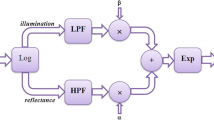Abstract
With the recent development of Cognitive Internet of Things (CIoT) and the potential of Cyber Physical System (CPS), people’s daily activities become smarter, and intelligent. The combination of CIoT and CPS can greatly enhance the quality of people’s life. To this end, this article proposes CIoT-CPS that comprises of two main models: user activity cognitive model and image authentication model.The user activity cognitive model (UACM) is a machine-learning model to have the meaningful data. The image authentication model is to verify the authenticity of images captured by various devices, such as smart phones, digital cameras, and other camera-embedded portable devices. The authenticity of an image is breached when parts of images are assembled to produce a new image (known as a splicing forgery), or a part of an image is copied or pasted into another part of the same image (known as a copy-move forgery). In the proposed verification method, an opposite color local binary pattern (OC-LBP) texture descriptor is applied to a questioned image. The image is first decomposed into an RGB (red, green, blue) and a luminance and chroma color spaces. The OC-LBP measures the interrelation between pixels of different color components. The intensive computation involving six color components and a gray version is performed in the cloud, where a server can be dedicated to doing this job. The histograms of the OC-LBP are concatenated with weights to produce a final feature vector of the image. A support vector machine is applied as a classifier, which classifies the image as authentic or forged. Several experiments were performed to verify the suitability of those models or approaches. The proposed approaches show a good accuracy compared to other competing approaches.

















Similar content being viewed by others
References
Chen M, Yang J, Hao Y, Mao S, Hwang K (2017) A 5g cognitive system for healthcare. Big Data Cogn Comput 1(1):1–5
Hwang K, Chen Min (2017) Big data analytics for cloud or iot and cognitive computing. Wiley, UK. ISBN: 9781119247029
Vlacheas P et al (2013) Enabling smart cities through a cognitive management framework for the internet of things. IEEE Commun Mag 51(6):102–111
Zhang M et al (2012) Cognitive internet of things: concepts and application example. Int J Comput Sci Issues 9(3):151–158
Wu Q et al (2014) Cognitive internet of things: a new paradigm beyond connection. IEEE Int Things J 1(2):129–143
Chen M, Ma Y, Li Y, Wu D, Zhang Y, Youn C (2017) Wearable 2.0: enable human-cloud integration in next generation healthcare system. IEEE Commun 55(1):54–61
Chen M, Yang J, Zhu X, Wang X, Liu M, Song J (2017) Smart home 2.0: innovative smart home system powered by botanical iot and emotion detection. Mobile Networks and Applications https://doi.org/10.1007/s11036-017-0866-1
Wan J, Cai H, Zhou K (2015) Industrie 4.0 enabling technologies. In: Proceedings of the international conference on intelligent computing and internet of things. Harbin, pp 135–140
Hossain MS, Muhammad G (2016) Cloud-assisted industrial internet of things (IIoT) - enabled framework for health monitoring. Comput Netw 101:192–202
Feng S, Setoodeh P, Haykin S (2017) Smart home: cognitive interactive people-centric internet of things. IEEE Commun Mag 55(2):34–39
Hossain MS (2017) Cloud-supported cyber-physical framework for patients monitoring. IEEE Syst J 11(1):118–127
Hossain MS, Rahman MA, Muhammad G (2017) Cyber physical cloud-oriented multi-sensory smart home framework for elderly people: energy efficiency perspective. J Parallel Distrib Comput 103:11–21
Wang J, Abid H, Lee S, Shu L, Xia F (2011) A secured health care application architecture for cyber-physical systems. Control Engineering and Applied Informatics (CEAI) 13(3):101–108
Foteinos V et al (2013) Cognitive management for the internet of things: a framework for enabling autonomous applications. IEEE Vehic Tech Mag 8(4):90–99
Sun Y, Todorovic S, Goodison S (2010) Local learning based feature selection for high dimensional data analysis. IEEE Trans Pattern Anal Machine Intell 32(9):1610–1626
AlSawadi M, Muhammad G, Hussain M, Bebis G (2013) Copy-move image forgery detection using local binary pattern and neighborhood clustering. In: European modeling symposium (EMS). Manchester, UK
Chang CC, Lin CJ (2010) LIBSVM—a library for support vector machine. http://www.csie.ntu.edu.tw/cjlin/libsvm
CASIA tampered image detection evaluation database. Downloadable at: http://forensics.idealtest.org
Muhammad G, Al-Hammadi MH, Hussain M, Bebis G (2014) Image forgery detection using steerable pyramid transform and local binary pattern. Mach Vis Appl 25(4):985–995
Wei W, Jing D, Tieniu T (2010) Image tampering detection based on stationary distribution of Markov chain. In: IEEE international conference on image processing (ICIP’10), pp 2101–2104
Hossain MS, Muhammad G (2016) Authenticated media uploading framework for mobile cloud computing. Memetic Comput 8(4):325–332
He Z, Lu W, Sun W, Jiwu H (2012) Digital image splicing detection based on Markov features in DCT and DWT domain. Pattern Recogn 45(12):4292–4299
Al-Hammadi MH, Muhammad G, Hussain M, Bebis G (2013) Curvelet transform and local texture based image forgery detection. In: Bebis G et al (eds) International symposium on visual computing (ISVC’13), Crete, Greece, July 29–31, 2013; ISVC 2013, Part II, LNCS 8034, pp 503–512
Hussain M, Muhammad G, Saleh SQ, Mirza AM, Bebis G (2013) Image forgery detection using multi-resolution weber local descriptors. In: Eurocon2013. Zagreb, Croatia, pp 1570– 1577
Acknowledgments
The authors are grateful to the Deanship of Scientific Research at King Saud University for funding this paper through the Vice Deanship of Scientific Research Chairs.
Author information
Authors and Affiliations
Corresponding author
Rights and permissions
About this article
Cite this article
Hossain, M.S., Muhammad, G. & AL Qurishi, M. Verifying the Images Authenticity in Cognitive Internet of Things (CIoT)-Oriented Cyber Physical System. Mobile Netw Appl 23, 239–250 (2018). https://doi.org/10.1007/s11036-017-0928-4
Published:
Issue Date:
DOI: https://doi.org/10.1007/s11036-017-0928-4




